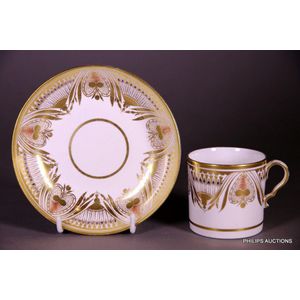Mid-century Limoges Porcelain Coffee Set for 10
You must be a subscriber, and be logged in to view price and dealer details.
Subscribe Now to view actual auction price for this item
When you subscribe, you have the option of setting the currency in which to display prices to $Au, $US, $NZ or Stg.
- Emeralds - Emeralds have been used in jewellery making for thousands of years, and are prized for their deep green colour, which is caused by the presence of chromium and vanadium in the mineral beryl. Because of their rare colour, emeralds are often more valuable than diamonds of a similar size and quality. In jewellery making, emeralds are typically cut into round or oval shapes to maximize their color and clarity. They are often set in gold or platinum and used as the centrepiece of a piece of jewellery, such as a ring or necklace. They can also be used in combination with other gems, such as diamonds, to create intricate and beautiful designs.
- Laurel Leaf - The use of the laurel leaf as a decorative element can be traced back to ancient Greece and Rome, where it was closely associated with victory and honour. In these cultures, the laurel was a sacred tree that was dedicated to the god Apollo and was believed to have protective and healing properties.
In ancient Greece, the laurel wreath was awarded to victors in athletic competitions, such as the Olympic Games, as a symbol of their achievement. The wreath was also associated with academic achievement, and was often worn by scholars and poets. The Greeks also used the laurel leaf as a symbol of victory in war, and it was often depicted in artwork alongside images of triumphant warriors and heroes.
The Romans continued this tradition, and the laurel wreath became a symbol of the highest military honor, the triumph, awarded to victorious generals. The wreath was also used to crown emperors and other important officials, and was often depicted in Roman art and architecture as a symbol of power and authority.
The laurel leaf is still used as a symbol of achievement, success, and excellence, and is frequently used in logos, emblems, and other branding materials. Its association with victory and honour has made it a popular choice for awards, medals, and other forms of recognition. - Gilding - Gilding is a method of ornamentation whereby a thin sheet of gold metal is applied to items made of wood, leather, ceramics, glass and silver for decorative purposes.
For furniture including mirrors, the sheet of gold is usually applied over a coating of gesso. Gesso is a mixture of plaster of Paris and gypsum mixed with water and then applied to the carved wooden frames of mirrors and picture frames as a base for applying the gold leaf. After numerous coats of gesso have been applied, allowed to dry and then sanded a coat of "bole", a usually red coloured mixture of clay and glue is brushed on and allowed to dry, after which the gold leaf is applied. Over time parts of the gilding will rub off so the base colour can be seen. In water gilding, this was generally a blue colour, while in oil gilding, the under layer was often yellow. In Victorian times, gilders frequently used red as a pigment beneath the gold leaf.
Metal was often gilded by a process known as fire gilding. Gold mixed with mercury was applied and heated, causing the mercury to evaporate, the long-term effect of which was to kill or disable the craftsman or woman from mercury poisoning. The pursuit of beauty has claimed many victims, not the least of which were the artists who made those pieces so highly sought after today. - Frieze - An architectural term denoting the flat, shaped or convex horizontal surface of furniture, between the architrave and the cornice, usually found on a cabinet or bookcase, or on desks and tables where it may include drawers, the area between the top and the legs. In ceramics, the term refers to the banding, of usually a repeating pattern, on the rims of plates and vases.
- Empire Style - The Empire style was a version of neo-classicism popular from 1800 to 1830, coinciding with the rule of Napoleon I from 1840-15. In England the style corrosponds with the Regency style and in the United States to the Federal style.
The style is inspired by classical Rome and Greece, as reflected in the decorative motifs in the the design such as paterae, guilloches, acanthus and swags, and pieces are lavishly decorated with applied gilded decoration. - Coffee Can - A coffee can is a cup for holding coffee, but of a cylindrical shape rather than the waisted shape of traditional cups. They were in use at the end of the 18th century and in the early 19th century.
This item has been included into following indexes:
- Limoges (France)
Visually similar items

Elizabeth II sterling silver bangle, hinged mechanism and box clasp Marked Birmingham Js 1966 approx 25 grams

A fine and rare Barr and flight & Barr Worcester cup and saucer, 1792-1807 both pieces, the striking gold spiral decorated straight sided cup with floral swags of summer blooms in vibrant colours, and a conforming saucer, the cup with an incised B mark and

A Spode coffee can and saucer, circa 1800-1805, unmarked, the can with a single kick to the looped handle, finely decorated to both pieces with formal borders of stylised heart shaped vegetal motifs and slender lappets, in gilt, with black and red accents,

A Royal Vienna demitasse cup and saucer, 19th century, with decoration by Neumann. The trumpet shaped cup with a high mounted scroll handle, a gilded interior and handpainted with an allegorical scene within a jewelled frame upon a bleu-de-roi ground with
